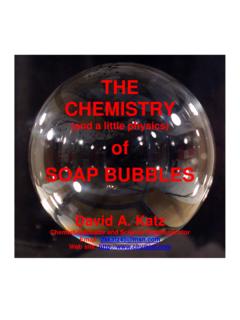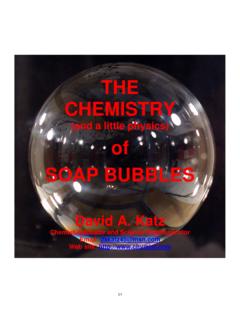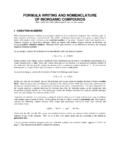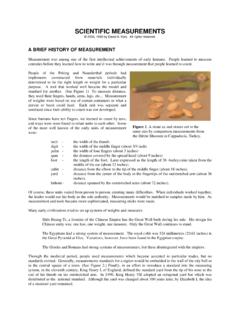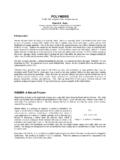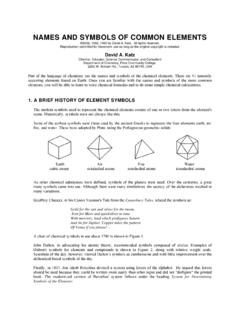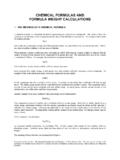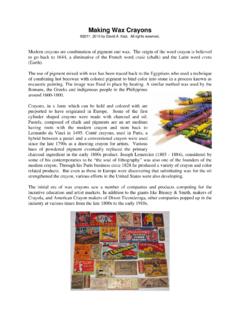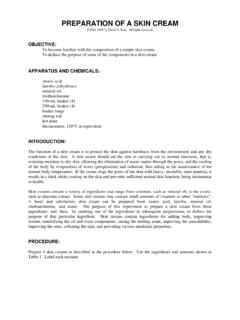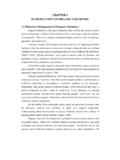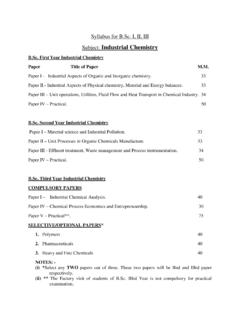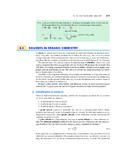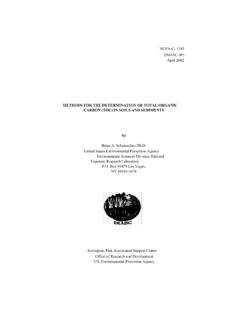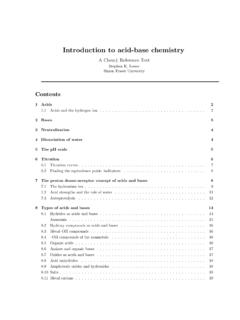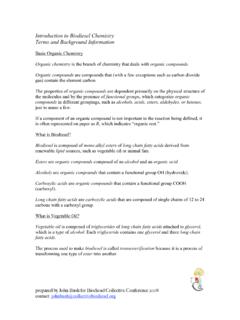Transcription of ESTERS An Introduction to Organic Chemistry Reactions
1 ESTERS An Introduction to Organic Chemistry Reactions 2006, 1990, 1982 by David A. Katz. All rights reserved. Reproduction permitted for educationa use provided original copyright is included. In contrast to inorganic Reactions , which usually involve metals combining with non-metals or polyatomic ions, Organic Reactions occur as additions or substitutions into a compound or as a condensation-type reaction where removal of certain atoms or groups cause two molecules to combine. One type of reaction, that will be observed in this experiment, is a dehydration between an Organic acid and an alcohol to produce an ester. An Organic acid has a structure: This compound, which contains two carbon atoms with a group on one end of the molecule is ethanoic acid, commonly called acetic acid or vinegar (a 5% solution of acetic acid).
2 An Organic alcohol has a structure: This compound, which contains two carbon atoms with a C-OH structure on one end of the molecule is ethanol, commonly called ethyl alcohol. When an Organic acid is mixed with and alcohol in the presence of a a strong, dehydrating acid, such as sulfuric acid, H2SO4, the molecules are joined together to form an ester with the removal of a water molecule: COHOH3C+H2 CCH3 HOCH3 COOH2 CCH3+H2OH2SO4 ethanoic acid ethanol ethylethanoate water (acetic acid) (ethyl alcohol) (ethyl acetate) To obtain the pure ester, one would have to distill it from the mixture of products obtained in the reaction.
3 The ester is called ethylethanoate, or commonly, ethyl acetate. ESTERS occur in many plants and are, in part, responsible for the distinctive odors of those plants and the flavors of their fruits. ESTERS are commonly used in the preparation of artificial flavors or fragrances. Flavors and fragrances may utilize a single ester or a mixture of ESTERS and other substances to duplicate the odor and flavor of a particular fruit. Some ESTERS that smell like common materials that can be prepared in the laboratory are listed in Table 1. CH3 COOHH2 CCH3 OHCOHOE sters can also be found in products such as scratch and sniff spots which are often used in magazines, direct mail advertisements, stickers, or children s books.
4 In these products, the ESTERS are microencapsulated. An individual usually uses a fingernail to mechanically break the small microcapsules to release the contents. Table 1. Common ESTERS used for flavors and fragrances Ester Smells like Prepared from Alcohol Acid isoamyl acetate Banana Isoamyl alcohol Acetic acid ethyl butyrate Pineapple Ethanol Butanoic acid benzyl acetate Peaches Benzyl alcohol Acetic acid n-propyl acetate Pears n-propyl alcohol Acetic acid benzyl butyrate Flowers Benzyl alcohol Butanoic acid methyl butyrate Apples Methanol Butanoic acid isobutyl propionate Rum Isobutyl alcohol Proprionic acid octyl acetate Oranges Octanol Acetic acid methyl anthranilate Grapes methanol 2-aminobenzoic acid Microencapsulation is a process where substances such as inks or dyes, adhesives, cosmetics.
5 Pharmaceuticals, or fragrances are contained in microscopic capsules, 20 to 150 microns in diameter, which can be broken mechanically, electrically, or chemically to release the contents. The microcapsules are composed of different materials depending on the substance packaged and the method by which it is to be released. Gelatin is widely used as an encapsulating agent. The advantage of microencapsulation is that the capsules remain stable and inert until broken down. PREPARING ESTERS PROCEDURE MATERIALS NEEDED: Organic acids and alcohols (see Table 1) sulfuric acid, H2SO4, or phosphoric acid, H3PO4 vials (screw cap or plastic snap cap) glass wool test tubes beaker for water bath droppers hot plate SAFETY PRECAUTIONS: Wear safety goggles or glasses Sulfuric acid is corrosive causing severe burns.
6 In the event of contact, rinse well with water for at least 10 minutes, then seek qualified medical assistance. Phosphoric acid is corrosive causing severe burns. In the event of contact, rinse well with water for at least 10 minutes, then seek qualified medical assistance. Concentrated acids react with water to produce heat. Always dilute acids by adding the acid to water slowly and with stirring. Organic acids may be irritants to the skin and eyes. Some have strong odors. Use any compounds with strong odors under a fume hood. Look up individual properties properties and hazards of each acid and take the recommended precautions. Organic alcohols are flammable. Avoid flames. Never heat any of the materials in this experiment directly, use a water bath.
7 If passing ESTERS around for individuals to smell, use small quantities with a piece of glass wool in the container to prevent splashing or spilling. DISPOSAL: All Organic materials should be disposed in the proper Organic waste containers. Dispose of concentrated acids by first diluting them by pouring the acid into a large beaker of water in a hood, and then neutralizing the solution with small amounts of sodium carbonate (washing soda) or sodium bicarbonate (baking soda). The neutralized solution can be poured down the drain. EXPERIMENTAL PROCEDURE: Examining a Scratch and Sniff Sticker Note the odor of a Smelly Patch/Sticker. Scratch the Smelly Sticker once or twice with your fingernail. Does the intensity of the odor increase? Bend the Smelly Sticker back and forth several times.
8 Does the intensity of the odor increase? Preparation of ESTERS This will be a group experiment. Each group will prepare one ester. The products will be placed in small vials and passed around to different groups. Using Table 1 ( Prepared from column) as a guide, mix about 3 mL of alcohol with 3 mL of Organic acid in a test tube. If the acid is solid, use a small amount, about the size of a match head. Add 5 drops sulfuric acid or phosphoric acid. The sulfuric acid should generate sufficient heat to initiate the reaction. The test tube may be heated in a boiling water bath for about five minutes to complete the reaction. Place a small piece of glass wool into a small vial. Pour the acidic ester mixture over a piece of glass wool in a small vial. This will prevent spilling or splashing if it is passed around to a group of people.
9 Label the vial with the name of the ester and the names of the individuals in your group. These samples of ESTERS should remain stable for several months. RESULTS: Ester Name Smells like
